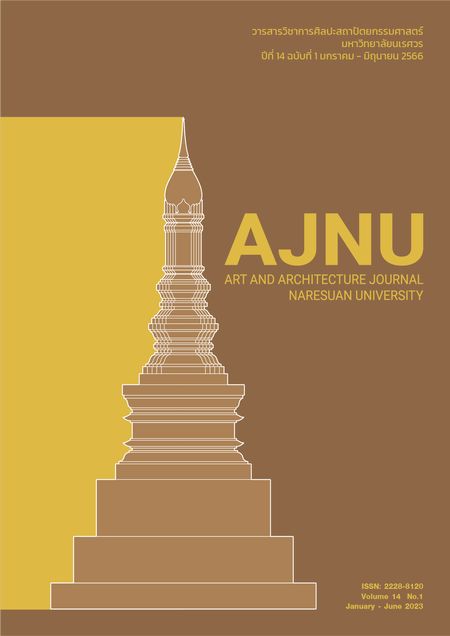The production of printing ink from virgin coconut oil and natural color in printmaking art
Main Article Content
Abstract
The Production of Printing Ink from Virgin Coconut Oil and Natural Color in Printmaking Art. The purposes of this research were to determine: (1) the appropriate conditions for virgin coconut oil and natural color extraction; (2) the study the properties of natural printmaking ink; 3) the minimize problems regarding chemical usage that may affect the users; and (4) the minimize environmental pollution generated from artwork. The methodology of this research divided in 4 steps; (1) studying the production of printing ink from virgin coconut oil and natural color in printmaking; (2) developing the tools to analyze the printing ink produced from virgin coconut oil and natural color in printmaking art; (3) collecting data from 32 samples from universities and art laboratories; and (4) validating the use of printing ink produced from virgin coconut oil and natural color in printmaking using checklist. Data analysis of this study comprised frequency, percentage, and content analysis of artwork. The findings of this study revealed that: (1) virgin coconut oil and natural color are appropriate for extraction; (2) printing ink extracted from natural material can be used in printmaking; (3) naturally extracted printing ink can minimize chemical effects on product users; and (4) naturally extracted printing ink can minimize environmental pollution due to artwork creation. Specialists and experts agreed that the printing ink produced from virgin coconut oil and natural color can be used in artwork creation in terms of correctness, appropriately, possibility, and utility.
Article Details

This work is licensed under a Creative Commons Attribution-NonCommercial-NoDerivatives 4.0 International License.
References
กระทรวงการอุดมศึกษา วิทยาศาสตร์ วิจัยและนวัตกรรม. นโยบายและยุทธศาสตร์การอุดมศึกษา วิทยาศาสตร์
วิจัย และนวัตกรรม พ.ศ.2563-2570. เข้าถึงเมื่อ 14 มกราคม 2563 จาก
การออกแบบงานศิลปะ, Theory visual arts ทฤษฎีทัศนศิลป์, เข้าถึงเมื่อ 30 เมษายน 2564 จาก
https://sites.google.com/site/karxxkbaebngansilpa/home/thvsdi-silpa-theory-of-art
แฉล้ม สถาพร. (2555). การสร้างสรรค์ผลงานศิลปะภาพพิมพ์ด้วยสีธรรมชาติจากพืชในจังหวัดนครศรีธรรมราช. วารสาร
วิจิตรศิลป์, 3(1) ,267-301.
ชญตว์ อินทร์ชา. (2562) การศึกษาศิลปะภาพพิมพ์เทคนิคเพลทแม่พิมพ์เจลลาตินด้วยการใช้สีธรรมชาติ ในท้องถิ่นของ
มหาวิทยาลัยราช ภัฏร้อยเอ็ด.วารสารมนุษยศาสตร์และสังคมศาสตร์ มหาวิทยาลัยราชภัฏอุดรธานี, 8 (2),109-124
ทฤษฏีสี (Color Theory).แรงดลใจจาก Children Driven Study. บทความโกทูโน, สืบค้นเมื่อ 30 เมษายน 2564
จาก https://www.gotoknow.org/posts/110160
พรพิมล ม่วงไทย และคณะ. (2553). การเตรียมผงสีย้อมจากเปลือกผลมังคุดบนสารดูดซับ. การประชุมวิชาการ
มหาวิทยาลัยเกษตรศาสตร์ วิทยาเขตกำแพงแสน ครั้งที่ 7.มหาวิทยาลัยเกษตรศาสตร์.
ราชกิจจานุเบกษา: เรื่อง ยุทธศาสตร์ชาติ (พ.ศ. 2561-2580) เล่ม 135 ตอนที่ 82 ก. เข้าถึงเมื่อ 30 เมษายน 2564 ,จาก http://www.ratchakitcha.soc.go.th/DATA/PDF/2561/A/082/T_0001.PDF
ราชกิจจานุเบกษา: พระราชบัญญัติส่งเสริมและรักษาคุณภาพสิ่งแวดล้อมแห่งชาติ (ฉบับที่ 2) พ.ศ.2561, เล่ม 135 ตอนที่ 27 ก สืบค้นเมื่อ 30 เมษายน 2564,จาก https://www.pcd.go.th/laws
ราชกิจจานุเบกษา พระราชบัญญัติ การส่งเสริมวิทยาศาสตร์ การวิจัยและนวัตกรรม พ.ศ. 2562 เล่ม 136 ตอนที่ 68 ก
สืบค้นเมื่อ 14 มกราคม 2563, จาก https://www.nu.ac.th/announcement/king/10-moe-science-
research-2562.pdf
สุรวิทย์ นันทการัตน์ และคณะ. (2563). การผลิตผงสีจากวัสดุธรรมชาติเพื่อผลิตภัณฑ์อาหาร. (รายงานการวิจัย).กรุงเทพ ฯ:
มหาวิทยาลัยเทคโนโลยีราชมงคงกรุงเทพ.
L. S. Siegel, F. J. Morrison: cognitive theory. ทฤษฎีการเรียนรู้ หรือ ทฤษฎีทางการศึกษา. สืบค้นเมื่อ 14
มกราคม 2563. จาก https://en.wikipedia.org/
Hard, A. & Sivik, L. ทฤษฎีสีกับการผสมสี. สืบค้นเมื่อ 14 มกราคม 2563. จาก https://en.wikipedia.org/
Vermont P. Dia., et al., .(2005). Comparative Physicochemical Characteristics of Virgin Coconut Oil
Produced by Different Methods. Philippine: Food Science Cluster, College of Agriculture
University. December 2005: No 4, 462-475.


